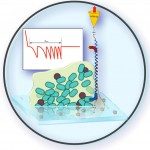Lien vers Pubmed [PMID] – 25208582
Nanoscale 2014 Nov;6(21):12665-81
Self-associating auto-transporter (SAAT) adhesins are two-domain cell surface proteins involved in bacteria auto-aggregation and biofilm formation. Antigen 43 (Ag43) is a SAAT adhesin commonly found in Escherichia coli whose variant Ag43a has been shown to promote persistence of uropathogenic E. coli within the bladder. The recent resolution of the tri-dimensional structure of the 499 amino-acids’ β-domain in Ag43a has shed light on the possible mechanism governing the self-recognition of SAAT adhesins, in particular the importance of trans-interactions between the L shaped β-helical scaffold of two α-domains of neighboring adhesins. In this study, we use single-molecule force spectroscopy (SMFS) and dynamic force spectroscopy (DFS) to unravel the dynamics of Ag43-self association under various pH and molecular elongation rate conditions that mimic the situations encountered by E. coli in its natural environment. Results evidenced an important stretchability of Ag43α with unfolding of sub-domains leading to molecular extension as long as 150 nm. Nanomechanical analysis of molecular stretching data suggested that self-association of Ag43 can lead to the formation of dimers and tetramers driven by rapid and weak cis- as well as slow but strong trans-interaction forces with a magnitude as large as 100-250 pN. The dynamics of cis- and trans-interactions were demonstrated to be strongly influenced by pH and applied shear force, thus suggesting that environmental conditions can modulate Ag43-mediated aggregation of bacteria at the molecular level.




